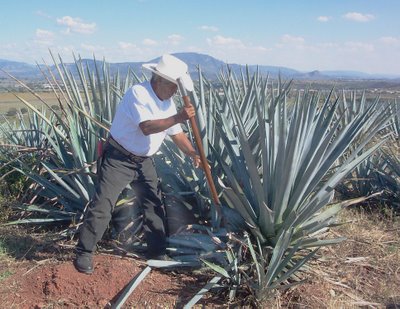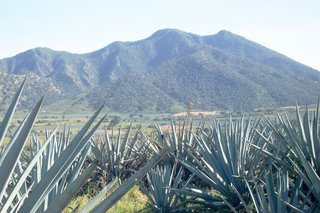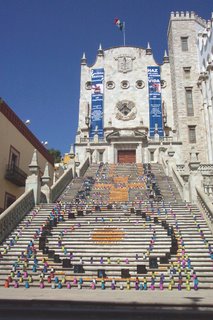
William M. Dowd photos
Mono's age was impossible to ascertain.
His naturally dark skin, dyed a deeper shade of mahogany by years in the unrelenting Jalisco sun, was creased enough to resemble a map of the Mexican state's meandering backroads.
But, it was his shoulders that drew the eye. Like large, knotted bunches of rocks, out of proportion to his physique yet supple enough to help maneuver the shovel-like coa de jima that helped him earn a living.
Again and again, the long-handled cutting tool flashed over the blue agave plant until the sharp outer leaves were gone and it was trimmed enough for other workers to pick up for transport to the nearby tequila distillery.
Mono, Spanish for monkey, got his nickname from his co-workers for his nimbleness in cutting and harvesting the huge cores of the plants used in making the best tequila.
The workers are known as jimadores. They are laborers who wield the coa, a long-handled tool with a razor-sharp curved blade, to chop off the long spiky leaves of the agave plants and sever the pina, the heart of the plant, from its shallow roots. A heart that can weigh as much as a man.
"Mire esto. Ahora, corte el aqui" -- Look at this. Now, cut it here -- Mono instructed an American visitor intent on slicing up his own agave plant. The visitor guided the coa in a downward swipe, again and again. One pina harvested and cleaned and his shoulders already hurt.
Mono and his fellow jimadores each cut loose and trim dozens of dense agave cores every day, destined for the nearby Don Eduardo processing plant on the outskirts of the city of Tequila. He sometimes harvests as many as 60 a day himself, starting at sunup and working quickly before the mid-day sun turns the sprawling fields into a shimmering blanket of heat mirages that blur into the soft blue haze created by the agave leaves.
The jimadores exist on one end of a food chain, or perhaps more accurately a beverage chain, that breathes life into the economy of Jalisco, the Mexican state recently named a World Heritage Site by the United Nations' UNESCO agency in honor of its agricultural and historical importance.
Jalisco (pronounced hah-lees-ko) is perhaps best known for its tequila and for several of its tourist-haven cities, Puerto Vallarta and Guadalajara, the latter the nation's second largest metro area after Mexico City.
The heralded tequila has as much of a national mystique as Champagne does in France or sake in Japan. And, it begins with Mono and his compatriots in the agave fields.
There are more than 130 types of agave, but it is the blue agave that is the epitome of the plant, the one whose pinas contain the clear sap from which the best tequila is made, a drink that supports an industry that supports a state that helps support a troubled nation.
 Blue agave grows in various parts of Mexico, but nowhere more in abundance than around Tequila, the town that gave the drink its name. From a distance, the huge fields of blue agave give the illusion of water. Close up, they evoke more of a dessert-like feel, the spiky blue-green plants springing from rich, brownish volcanic soil.
Blue agave grows in various parts of Mexico, but nowhere more in abundance than around Tequila, the town that gave the drink its name. From a distance, the huge fields of blue agave give the illusion of water. Close up, they evoke more of a dessert-like feel, the spiky blue-green plants springing from rich, brownish volcanic soil.Unlike the jagged peaks and thin air of the great plateau just to the northeast that sweeps up to Mexico City and its hideous urban blight, Jalisco offers valleys, sprawling vistas, clean cities, fertile farmland and a deep historical significance as a center of indigenous culture and birthplace of Mexican democracy.
This state of 6.7 million people -- which stretches from central Mexico west to the Pacific Ocean -- is increasingly attracting foreign tourists as well as expatriate American and European residents drawn by the mild climate, relaxed pace and inexpensive living conditions (about 10 pesos to the U.S. dollar).
Tourism is a major economic necessity for Jalisco, but its attractions are markedly different from each other. Puerto Vallarta, for example, has grown from a seaside fishing town to a glitzy, international tourist haven of 180,000 residents, thanks to its Pacific location and sophisticated marketing. Inland, Guadalajara, a city of 3 million in a metro area of 4.7 million, is a tourist
attraction that has remained very culturally Mexican.
Greater Guadalajara, which includes the adjacent city of Zapopan, is a place of side-by-side cultures -- a proud show of modernity with signs for Sony, Reebok, McDonald's and Blockbuster, but a reverence for displaying the elements of pre-European influence in museums and galleries.
It also is a place that can literally be taken several ways. Just as mimes must have fans somewhere on this globe, not everyone thinks of mariachi music as a musical form of joke despite the best efforts of late-night American television comics who love using those bands as props.
Mariachi was born in Guadalajara, springing from the stuff of wedding bands into a full-blown art form complete with its own music, costuming and protocols. Large crowds gather in mariachi halls that resemble European beer gardens to listen to, and sing along with, the mariachi bands. Even the elaborate clothing of the charro, the traditional cowboy of Mexico, owes its design sensibilities to the form-fitting, embroidered mariachi suits and wide-brimmed sombreros.
Events revolving around churches and church traditions still are extremely prominent in this Catholic country. One of the most festive times is Dia de los Muertos, the Day of the Dead festival which actually covers both Nov. 1 and 2. It is a time for cheerful remembrances of the departed with cemetery visits, restrained festivities, and literally thousands of makeshift altars springing up in homes, businesses and on the streets.
 Even the steps of one large cathedral in Guadalajara are turned into a temporary altar each year, festooned with bright orange flowers, candles and photographs of the dead. Streets leading to churches and cemeteries are lined with vendors selling fresh-made foods and handicrafts and youngsters sell coffee cans full of water for a peso to visitors who want to wash down tombstones.
Even the steps of one large cathedral in Guadalajara are turned into a temporary altar each year, festooned with bright orange flowers, candles and photographs of the dead. Streets leading to churches and cemeteries are lined with vendors selling fresh-made foods and handicrafts and youngsters sell coffee cans full of water for a peso to visitors who want to wash down tombstones."It's tough to scale down the list of things to do here," local twentysomething businessman Javier Orendain Hernandez told a visitor. "We have the traditional things like the charreadas" -- a type of rodeo -- "and the Sunday bullfights, and of course the museums and the churches and festivals. But, the nightlife is great and getting bigger all the time with dance clubs and bars. That might exhaust you so much you won't want to do a lot of walking the next day.'"
Orendain Hernandez's cautionary advice is an object lesson about the emerging younger generation of which he is a part. It is helping create a larger, stronger middle class in a nation traditionally divided into haves and have-nots.
Increasingly college educated, demonstrably entrepreneurial, and relentlessly in search of modern diversions, they are helping build a society that attracts international travelers and financial investment, fueling a continual growth that demands better choices and improved infrastructure.
Water quality, long a bad joke in many parts of Mexico, is quite good in Jalisco with hygienic, well-maintained municipal supplies, although visitors usually are advised to stick to bottled water as a precaution.
Huge swaths of streets in most cities are being upgraded with modern cobblestones that maintain the historic look but offer more durable pathways, accented by lush plantings of flowers and shrubs. Street sweepers are commonplace. Graffiti is so rare it startles you when it's evident.
The toll highways between cities are in good repair and well protected against bandits by federales, well-armed federal police, things that cannot be said of some of the free highways where lawlessness is common.
Guadalajara also offers an international airport, well-regulated taxi and bus services, numerous well-tended parks and intricate fountains, plus innumerable cafes and restaurants that are inviting stopping places on sultry afternoons for anything from a beer or soft drink to a tequila tasting accompanied by fresh cheeses, salted pineapple chunks, spiced nuts and crisp breads.
Many first-rate hotels are hidden behind rather plain facades that don't tend to attract unwanted attention. The same goes for homes of most of the financial upper class. Behind the walls, like a pampered senorita freed from the presence of a strict chaperone, courtyards burst loose with flowers and plants and shade trees.
Guadalajara's historic city center is dominated by Spanish colonial architecture, its ornate churches presenting the most striking examples. The main cathedral there is home to the state tourism office where you can pick up a free walking-tour
map. If your feet hurt, catch a calandria, a horse-drawn carriage that can be hired at the historic enter or at various other stations.
There also is a top-flight children's zoo and a connected amusement park, called Selva Magica, that has 35 rides, a marine park, and various water and bird shows. Tennis courts and golf courses are readily available at various points around the city.
Perhaps the two must-see parks in the city are Los Colomos and Parque Agua Azul (Blue Water Park). The former is located in a forest within the city and includes the Japanese Gardens, donated by Guadalajara's sister city of Kyoto, Japan. The latter is divided into two parts connected by a bridge and usually offers strolling musicians as well as the adjacent Archaeological Museum of Western Mexico that holds exhibits of artifacts used by the ancient peoples of the surrounding area.
The town of Tequila, northwest of Guadalajara on the road to Puerto Vallarta, is a comparatively quiet one, its population of 45,000 a mere shadow of Guadalajara's. But it is the home of the Tequila Museum, an interesting place if one is at least somewhat conversant with Spanish. Oddly for an institution that was created to explain the tequila tradition and industry to visitors, it is presented only in Spanish.
Some of the local tequila manufacturing facilities are open for tours, but they should be booked ahead of time because production is not always at full throttle.
When it is, don't expect the sharp, sometimes off-putting smells of distilleries and breweries. The aroma of the tequila process is quite pleasant, a light mix of citrus and flowers.
As one female American visitor was overheard saying, "Forget about drinking the stuff. If they could bottle tha fragrance they'd make a fortune.''

IF YOU GO
Location: Jalisco, one of Mexico's 31 states, is located in the center of the country, stretching west to the Pacific Ocean.
Key Cities: Guadalajara, Puerto Vallarta, Tequila.
Main Airports: Don Miguel Idalgo Airport in Guadalajara, Gustavo Diaz Orzaz Airport in Puerto Vallarta.
Language: In Jalisco state, you'll hear mostly Spanish even though Mexico has 62 living indigenous languages, second in the world only to India's 65. English is common in major cities and at all hotels and restaurants.
Currency: The peso, worth approximately 10 U.S. cents.
Documentation/Fees: Effective Jan. 1, 2007, all persons traveling by air between the U.S. and Mexico will be required to present a valid passport. Visitor exit document provided upon arrival is necessary for departure or $43 fee is charged for replacement. Departure tax of $10 must be paid at the airport when not included in the cost of the airline ticket. Customs declaration forms, available from airlines, required upon entry and departure.
• Driving in Mexico.
• Emergency medical care in Puerto Vallarta and in Guadalajara.
• Best tip of all: Bring your own toilet paper. Most public facilities dole it out by the square, for a price, and this is the home of one-ply tissue.
1 comment:
I agree that Jalisco, and Guadalajara are wonderful places to visit. Don't miss a trip on the Tequila Express from Guadalajara to Amatitan. This was one of the highlights of my trip to the area—fun for everyone—a mix of Mexican nationals and foreigners, kids, young adults and a few grandparents, too. Everyone had a fantastic time.
Karen, New York
Post a Comment